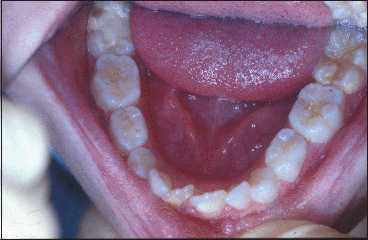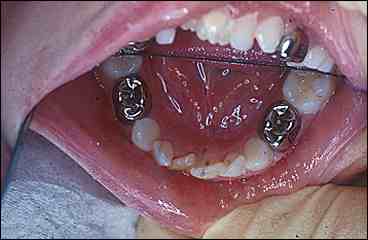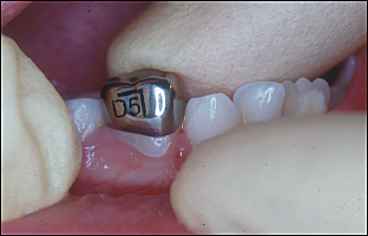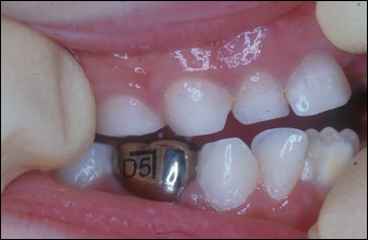Ths peer reviewed article was first published in the journal Tuith OnlineThe Hall technique: a pilot trial of a novel use of preformed metal crowns for managing carious primary teethAbstract Objective
IntroductionDental decay in primary teeth is a significant health problem. Scottish children have the highest decay rates in Europe, with 52% of 5-year-olds having at least one decayed tooth (O'Brien, 1994). Conventional restorative techniques for managing this decay have been found effective when used in specialist practice (Roberts and Sherriff, 1990) and dental hospitals (Wellbury et al., 1991). However, these techniques do not appear to be popular with general dental practitioners (GDPs) in primary care (where over 90% of child dental care is provided), with one survey finding that less than 9% of cavities in primary teeth in 5-year-olds are being restored (Pitts et al., 1998) . One consequence of this untreated disease is that 43% of Scottish 8-year-olds have had at least one tooth extracted (O'Brien, 1994). Preformed metal crowns (PMCs) are widely regarded as the optimum restoration for primary molars with advanced decay. The standard technique involves obtaining local anaesthesia, then cutting mesial, distal, and occlusal slices from the tooth, before cementing on the crown. Despite out-performing all other restorations (Randall et al., 2000), the technique is little used in primary care. For example, in a 9 month period during 1996/97 for which records are available, only 154 PMCs were fitted by GDPs for children in the general dental services in Scotland, compared with 121,000 teeth extracted from children in the same period (Scottish Dental Practice Board, 1997). However, one of the authors (NH) has modified the technique and simply cements the crowns onto carious primary teeth without local anaesthesia, caries removal, or tooth preparation of any kind. The management of carious lower Ds using this method (now referred to as the Hall technique) on a patient who was not part of the current study, is shown in Figures 1 and 2. Figure 1.
Figure 2.
The expectation is that the caries, being sealed in, will arrest. An audit of 111 crowns cemented using the Hall technique, and followed up for a minimum of two years (Dr N. Hall, personal communication) gave the following results; Table 1. Fate of 111 crowns monitored for a minimum of two years after fitting.
No reliable data is currently available for the longevity of conventional restorations placed in primary teeth in Primary care. However, the audit results for the Hall technique would seem to be similar to what might be expected from conventional restorative techniques, while being less invasive, and less demanding of both the operator and the child. Clearly, an evidence-base is required for the Hall technique before it can be recommended for use in primary care, and this will require a randomised control clinical trial. However, before such a study could be organised, there was a need for the generalisability of the technique in primary care to be investigated in a pilot trial. This was the aim of the present study. Aims:The aim of this study was to determine the acceptability of the Hall technique to a range of dentists and their patients. Method:The study was run in partnership with the Tayside Primary care research network, TayRen, who provided funding for the GDPs involved, and with 3M, who provided the GDPs with preformed metal crown kits. Eight dentists (four GDPs, who were members of TayRen, and four dentists from Dundee Dental Hospital and School) volunteered to participate in the study. Each dentist was asked to recruit 10 patients who met the following criteria:
TayRen funding allowed two GDPs and a hospital dentist to visit Dr Hall's practice for training in the Hall technique; these dentists then, in turn, trained the remaining study dentists. The Hall techniqueThe Hall technique is a method of managing carious primary molars using PMCs, but without any tooth preparation, caries removal, or the use of local anaesthesia. The technique is as follows:
Figure 3.
Figure 4.
Patient, parent, and dentist acceptability was determined by questionnaire completed at the cementation appointment. Local Ethics committee approval was obtained, and informed consent was obtained from patients and parents a minimum of 24 hours after the study had been discussed with them. Results:Numbers of crowns successfully fitted Eight dentists were asked to recruit 10 patients each, and to fit one crown to each patient using the Hall technique. The number of patients recruited by the dentists, and the number of crowns successfully fitted are shown in Table 2. Table 2. Numbers of patients recruited and crowns successfully fitted by study dentists.
Patient acceptability After fitting the crown, patients were asked, "If you had to have another filling, would you like it done the same way?" Of the 45 children who had crowns fitted, all 45 reported the procedure as being acceptable, and would have it again. When asked why, 24 out of 45 made positive comment:
Children were asked, "Was there anything you didn't like?" 9 out of 45 made negative comments:
Parent acceptability After fitting the crown, parents were asked, "If your child had to have another filling, would you like it done the same way?" Of the 45 crowns fitted, parents declared the technique as acceptable in 44 cases. For one case, the parent initially didn't like the colour of the crown, but was satisfied at one week review. 31 parents out of 45 made positive comments
Dentists were asked to give their subjective impression of the discomfort experienced by the child during the cementation of the crown, and the results are shown in Table 3. Table 3. Dentists assessment of discomfort experienced by children (n=45) during cementation of the crown.
Table 4. Percentages of crowns fitted within measured time bands (crowns, n=45). Percentages are additive.
The sizes of the crowns fitted are shown in Table 5. Table 5. Size of cemented crowns (n=45)
Dentists were asked to record by how much the occlusion was propped open after crown cementation, when measured from the incisors. This is shown in Table 6. Table 6. Reduction in incisor overbite following crown cementation (n=45 patients)
Discussion:Forty-five crowns were successfully fitted using the Hall technique for 49 of the patients recruited. It was disappointing that four of the eight dentists failed to meet their targets for patient recruitment, despite having over six months to complete the trial. Reasons given were connected to the availability of patients who met the study criteria, rather than problems with the technique. The two GDPs who failed to meet their targets remain enthusiastic about the technique, and continue to use it in their clinical practice. The variable commitment of dentists participating in clinical trials is a well recognised problem with running such trials, and it is of interest that for the four patients where the attempt to fit a crown was unsuccessful, in all cases the dentists involved were those who failed to meet their targets. The next stage of the study is to set up a randomised control clinical trial, and considerable attention will have to be paid towards dentist recruitment, in order to avoid wasting resource. The results indicate that both dentists, patients, and parents find the Hall technique an acceptable method of managing carious primary molars. It might be assumed that forcing a PMC through contact points, on unprepared teeth, would cause significant discomfort, but this did not seem to be the case. This may be because children themselves are responsible for seating the crown. By giving the child control over what is happening to them, their anxiety levels may be reduced to level where the sensation they feel is not perceived as painful. Personal experience would indicate that the child biting the crown into place themselves, rather than the clinician seating it, is a key part of a successful application of the Hall technique. For teeth where loss of the marginal ridge has led to loss of mesial/ distal width, with subsequent difficulty in finding a PMC which will fit, the use of orthodontic elastic separators for three to four days prior to cementation can be useful. Orthodontic separators were, however, not used in this current trial. The bite was usually propped open to some degree using the technique, but this did not seem to cause the problems usually associated with premature contacts, even though the study used the "worst case scenario", that of fitting a single crown. The occlusion usually returned to balanced contacts within a few weeks. It may be that children's occlusions are more accepting of occlusal disharmonies than are adult occlusions. Certainly, the average orthodontic appliance, particularly of the functional type, seems to cause few problems. The proposed randomised control trial will be designed to monitor for longer-term effects. Whether the Hall technique is effective or not will depend on the caries being arrested once sealed within the PMC. There is increasing evidence that caries can slow or even arrest if completely sealed in (Mertz-Fairhurst et al., 1992; Weerheijm et al., 1992; Kreulen et al., 1997; Handleman et al., 1986), although whether the Hall technique gives an adequate seal can only be determined from a longitudinal clinical trial. If the Hall technique is found to be effective, it could be a useful option when managing caries in primary molars. In addition, the technique is particularly 'low-tech', requiring no rotary instruments or compressed air, making it potentially of use in countries where there is limited access to dental care. In any event, the Hall technique will need both an evidence-base, and to be applied in the context of a full preventive programme if it is to make an effective contribution to improving child dental health. Conclusions:The Hall technique would seem to be acceptable to a range of dentists, and their patients and parents. A randomised control clinical trial is now in progress to determine whether the technique is effective in managing carious primary molars. The technique cannot be recommended for routine use outside clinical trials until this information is available. Acknowledgements:The authors would like to acknowledge their gratitude to Professor Nigel Pitts, Director, Dental Health Services Research Unit, Dundee Dental Hospital and School and Dr Ros Randall, of 3M, for their support and encouragement in running this study. The authors would also like to thank Dr Brian Bonner for preparing the illustrations. References:Handleman, S.L., Leverett, D.H., Espeland, M.A., and Curzon, J.A. (1986) Clinical and radiographic evaluations of sealed carious and sound tooth surfaces. Journal of the American Dental Association. 113; :751-754 Kreulen, C.M., de Soet, J.J., Weerheijm, K.L., van Amerongen, W.E. (1997) In vivo cariostatic effect of resin modified glass ionomer cement and amalgam on dentine. Caries Research 31; 384-389. Mertz-Fairhurst, E.J., Smith, C.D., Williams, J.E., Sherrer, J.D., Mackert, J.R., Richards, E.E., Schuster, G.S., O'Dell, N.L., Pierce, K.L., Kovarik, R.E., and Ergle, J.W. (1992) Cariostatic and ultraconservative sealed restorations: six-year results. Quintessence International. 23; 827-838. O'Brien, M (1993). Children's Dental Health in the United Kingdom. HMSO 1994 Pitts, N.B., Nugent, Z.J.. and Smith, P.A. (1998) Scottish Health Boards Dental Epidemiological Programme. Report on 1997/1998 Survey of 5-year-old children. URL: http://www.dundee.ac.uk/dhsru/shbdep97/ Randall, R.C., Vrijhoef, M.A., and Wilson, N.H.F. (2000) Efficacy of preformed metal crowns vs amalgam restorations in primary molars; a systematic review. Journal of the American Dental Association 131; 337-343. Roberts, J.F. and Sherriff, M. (1990) The fate and survival of amalgam and preformed crown molar restorations placed in a specialist paediatric dental practice. British Dental Journal 169; 237-244. Scottish Dental Practice Board Annual Report 1996/97. Trinity Park House, Edinburgh Hall, N. General Dental Practitioner, The Dental Practice, 61 Moss Street, Keith, Aberdeen AB55 3HF Personal communication. Weerheijm, K.l., de Soet, J.J., van Amerongen, W.E., and de Graaff, J. (1992) Sealing of occlusal hidden caries lesions: An alternative for curative treatment? Journal of Dentistry for Children. 263-268 Wellbury, R.R., Walls, A.W.G., Murray, J.J., and McCabe, J.F. (1991) The 5-year results of a clinical trial comparing glass poly-alkenoate cement restoration with an amalgam restoration. British Dental Journal. 170; 177-181. Author details:
Reviewers:
The Hall technique:A pilot trial of a novel use of preformed metal crowns for managing carious primary teeth. by Evans, D.J.P.1, Southwick, C.A.P.2, Foley, J.I.3, Innes, N.P.4, Pavitt, S.H. 5, and Hall, N 6. 1-6 details listed at the end of the article. Correspondence to Dr Dafydd Evans, e-mail d.j.p.evans@dundee.ac.uk. Download this article in Adobe pdf format (requires reader available free from Adobe) © Tuith Online 2000. |
||||||||||||||||||||||||||||||||||||||||||||||||||||||||||||||||||||||||||||||||||||||||||||||||||||
|
Web space provided by the University of Dundee,
maintained by
the Dental Health Services Research Unit. Valid XHTML1.0
|
 |
Evidence-based dentistry web-site | |